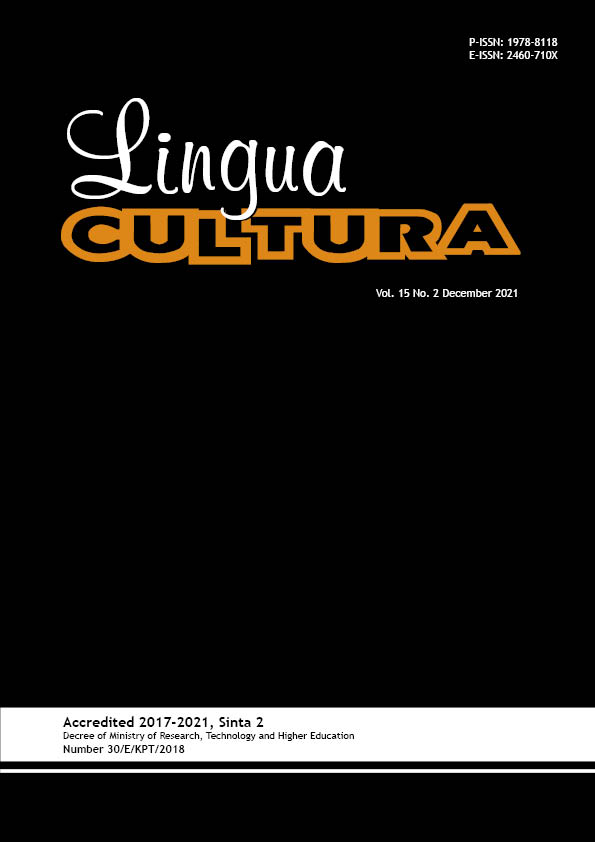The Reflection of Wabi Sabi in the Novel Joseito by Dazai Osamu
DOI:
https://doi.org/10.21512/lc.v15i2.7004Keywords:
collective values, honne, tatemae, Japanese cultureAbstract
The research examined the life’s perspective of the author that was reflected in wabi sabi in the novel ‘Joseito’ by Dazai Osamu. The life of the Joseito character described by Dazai Osamu in the Joseito novel had individual values (honne), and Joseito desired to equate it with collective values (tatemae). However, Joseito could not unite the two contradictory values and accepted the contradiction. The method used was descriptive qualitative, with the sociology of literature approach and focused on the sociology of the author using the concept of wabi sabi. Data on wabi sabi were collected from reading Joseito’s novels. The research results find that Dazai Osamu sincerely accepts the contradictions in Japanese society because Dazai can place himself where he is. Dazai is willing to accept contradictions in Japanese society by understanding the meaning of wabi sabi. He learns to appreciate, accept what it is, and be grateful for the contradictions in society because these contradictions can establish harmony in a beautifully ordered life through wabi sabi.
References
Cahyaningati, D. T. (2018). Portraying the Wabi Sabi philosophy of beauty in Kawabata’s Snow Country. Dinamika: Jurnal Sastra dan Budaya, 6(1), 628-639. http://dx.doi.org/10.25139/dinamika.v6i1.1181.
Cooper, T. M. (2018). The wabi sabi way: Antidote for a dualistic culture? Journal of Conscious Evolution, 10(10), 1-13.
Doi, T. (2005). Understanding amae: The Japanese concept of need-love. UK: Global Oriental Ltd.
Fatonah. (2017). Belajar dari karakteristik bangsa Jepang dalam menghargai kebudayaan. Tsaqofah & Tarikh, 2(2), 119-132. http://dx.doi.org/10.29300/ttjksi.v2i2.711.
Gantar, L. (2017). Ancient Greek legend in modern Japanese literature: â€Run Melos!†By Dazai Osamu. Acta Linguistica Asiatica, 7(2), 51-68. https://doi.org/10.4312/ala.7.2.51-68.
Harun, Y., & Biduri, F. N. (2019). Perspektif budaya bisnis dan etos kerja masyarakat Jepang dan Tiongkok. Criksetra: Jurnal Pendidikan Sejarah, 8(2), 98-106. https://doi.org/10.36706/jc.v8i2.9244.
Huriyah, T. A., Febrianty, F., & Kurniawan, S. (2020). Honne dan tatemae dalam novel ‘Sairensu’ karya Akiyoshi Rikako. Janaru Saja, 9(2), 52-59. https://doi.org/10.34010/JS.V9I2.4145.
Iqbal, C. I. (2018). Budaya komunikasi dalam masyarakat Jepang. Walasuji: Jurnal Sejarah dan Budaya, 9(1), 113-128. https://doi.org/10.36869/wjsb.v9i1.25.
Mulyaningrum, M., Dian, B. F., & Haryono. (2020). Analisis kekerasan simbolik dalam cerpen Viron No Tsuma karya Dazai Osamu: Sebuah kajian Sosiologi Sastra. CHI’E: Jurnal Pendidikan Bahasa Jepang, 8(1), 68-76. https://doi.org/10.15294/chie.v8i1.36737.
Nilamsari, E. D. C. A., & Nugroho, R. D. (2020). Honne tatemae sebagai cerminan interaksi masyarakat Jepang dalam drama 1 Rittoru No Namida karya sutradara Masanori Murakami. Mezurashii: Journal of Japanese Studies, 2(2), 25-40. https://doi.org/10.30996/mezurashii.v2i2.4301 .
Odagiri, J. (2020). Repackaging Dazai Osamu and the process of branding â€Ningen Shikkakuâ€. è¶Šå¢ƒæ–‡åŒ–ç ”ç©¶ã‚¤ãƒ‹ã‚·ã‚¢ãƒ†ã‚£ãƒ´è«–é›†, 3, 77-89.
Orgad, Y. (2017). On wabi sabi and the aesthetics of family secrets: Reading Haruki Murakami’s Kafka on the Shore. Culture & Psychology, 23(1), 52-73. https://doi.org/10.1177%2F1354067X16650811.
Osamu, D. (1997). Joseito. Tokyo: Haruki Kadokawa.
Palandi, E. H. (2020). Filosofi dalam konsep Omotenashi pada tindak tutur bahasa Jepang. Japanese Language and Culture, 7, 1-13.
Prativi, N. M. B. D., Budiarsa, M., & Erawati, N. K. R. (2019). Principle of politeness in the use of Hairyo Hyougen in Japanese drama: A pragmatic study. American Journal of Humanities and Social Sciences Research (AJHSSR), 3(9), 67-72.
Puspitasari, D. (2018). Konstruksi identitas perempuan Jepang melalui geisha dalam novel Indonesia. Prosodi: Jurnal Ilmu Bahasa dan Sastra, 12(1), 179-185. https://doi.org/10.21107/prosodi.v12i1.3941.
Ratna, N. K. (2012). Penelitian sastra: Teori, metode, dan teknik. Yogyakarta: Pustaka Pelajar.
Ristiawati, T. (2019). Social concept in Tanin No Kao by Abe Kobo. Jurnal International Seminar on Languages, Literature, Art and Education (ISLLAE), 1(1), 157-162. https://doi.org/10.21009/ISLLAE.01125.
Safari, D. M. (2018). Novel Belantik karya Ahmad Tohari: Pendekatan Sosiologi Sastra. Jurnal Bindo Sastra, 2(1), 183-187. https://doi.org/10.32502/jbs.v2i1.928.
Senen, M., & Piri, E. N. (2019). Analisis penerapan karakter â€Kawai Bunka†dalam kehidupan masyarakat Jepang. Jurnal Elektronik Fakultas Sastra Universitas Sam Ratulangi, 2(2), 1-8.
Sudarsih, S. (2018). Reformasi kebudayaan masyarakat Jepang. Kiryoku, 2(2), 78-82. https://doi.org/10.14710/kiryoku.v2i2.78-82.
Sudarsih, S. (2019). Pentingnya keteladanan orang tua dalam keluarga sebagai dasar dalam pembentukan karakter masyarakat Jepang (Suatu tinjauan etis). Kiryoku, 3(1), 58-63. https://doi.org/10.14710/kiryoku.v3i1.58-63.
Terao, I. (1971). Bi no Ronri - Kyo to Mi no Aida. Tokyo: Sogensha.
Zorana, V., & Jim, G. (2020). Conceptualization of anger in English and Japanese.「文å¦éƒ¨ç´€è¦ã€æ–‡æ•™å¤§å¦æ–‡å¦éƒ¨ , 34(1), 1-46. http://doi.org/10.15034/00007629.
Downloads
Published
How to Cite
Issue
Section
License
Copyright (c) 2021 Aminah Hasibuan, Rima Devi, Ferdinal

This work is licensed under a Creative Commons Attribution-ShareAlike 4.0 International License.
Authors who publish with this journal agree to the following terms:
a. Authors retain copyright and grant the journal right of first publication with the work simultaneously licensed under a Creative Commons Attribution License - Share Alike that allows others to share the work with an acknowledgment of the work's authorship and initial publication in this journal.
b. Authors are able to enter into separate, additional contractual arrangements for the non-exclusive distribution of the journal's published version of the work (e.g., post it to an institutional repository or publish it in a book), with an acknowledgment of its initial publication in this journal.
c. Authors are permitted and encouraged to post their work online (e.g., in institutional repositories or on their website) prior to and during the submission process, as it can lead to productive exchanges, as well as earlier and greater citation of published work.
USER RIGHTS
All articles published Open Access will be immediately and permanently free for everyone to read and download. We are continuously working with our author communities to select the best choice of license options, currently being defined for this journal as follows: Creative Commons Attribution-Share Alike (CC BY-SA)


















